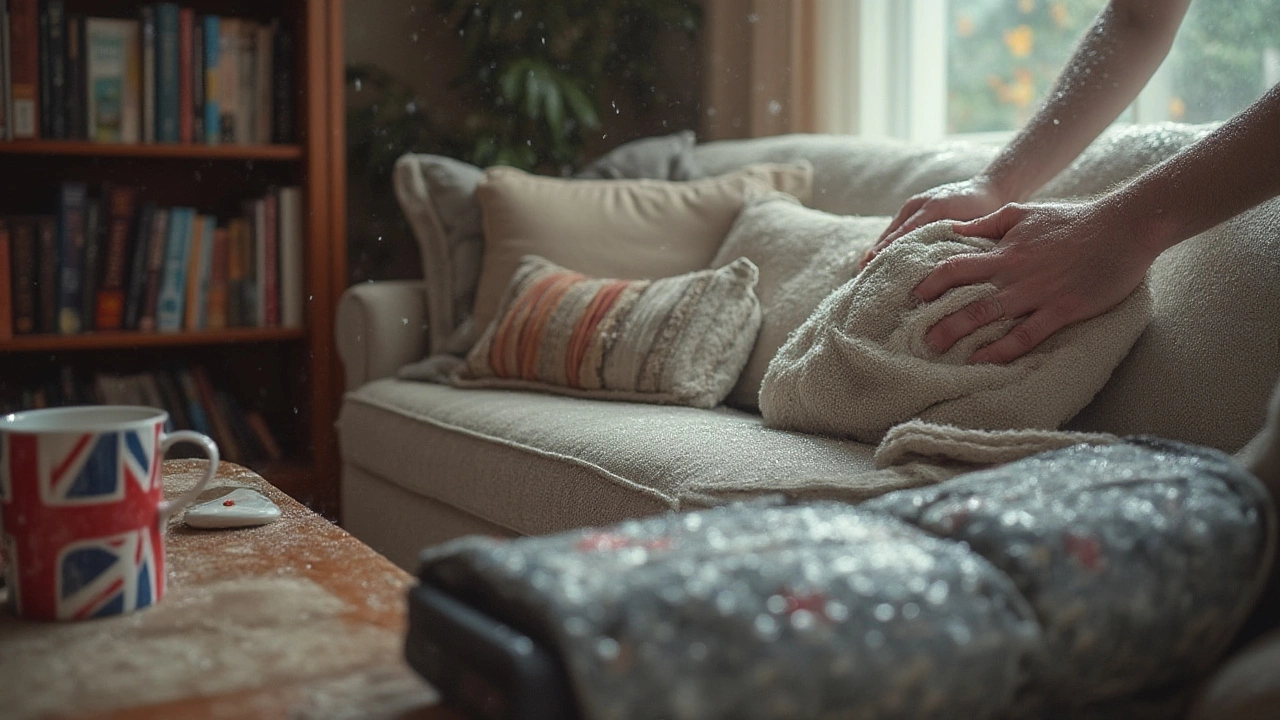If you’ve ever shampooed your couch and thought, “Now what?” there’s a good chance you’ve underestimated just how stubborn moisture can be. One minute, you’re proud of your clean sofa, the next, you realise it’s taking all day—or all night—to dry. And you can’t lounge on it, you’re worried about mould, and your whole living room smells slightly like wet dog. Let’s face it, a damp couch is almost as stressful as a dirty one. Drying your couch after shampooing isn’t just about impatience; it’s about keeping it hygienic, safe, and comfortable. But getting it bone dry, and quickly, is an art more than a science. Here’s how to do it right—no guessing, no waiting hours longer than needed.
Why Proper Couch Drying Matters (and How Much Can Go Wrong)
Shampooing a couch should leave it fresher, but if it stays wet too long, things get gross fast. Moisture trapped in upholstery foam and fabric is a perfect breeding ground for bacteria and mould. According to an NHS report, mildew can start forming within 24-48 hours on damp fabrics, especially in warm rooms. Besides the health risks—triggering allergies, asthma, and sneezing fits—you’ll get lingering odours that no scented candle can mask.
But the drama doesn’t end there. Damp foam won’t just attract dust mites; it can also cause colours to bleed, particularly on cotton or linen sofas. Patterns may smudge, cushion cores might wallow out of shape, and any timber in the frame could even start to warp if drying takes too long. Upholstery cleaning guides published by the British Institute of Cleaning Science warn that improper drying causes as much long-term damage as the initial spill that made you shampoo it in the first place.
Here’s a quick look at what can happen if you don’t dry your sofa thoroughly and fast enough:
| Problem | Consequence |
|---|---|
| Mould & mildew | Foul smell, allergies, visible spots |
| Colour bleeding | Patchy, faded fabric |
| Warped frame | Sagging or cracking in wooden base |
| Permanently creased covers | Sofa loses shape and looks tired |
In case you’re wondering, even quick shampooing with ‘low-moisture’ methods can leave a surprising amount of water behind. Typical household wet vacuums only pull out about 80% of liquid at best, and that’s assuming you go over every hidden seam and corner. The rest? It lingers—unless you tackle it the right way.
Prepping Your Couch For Fast Drying Before You Even Start
Nobody likes tedious prep work, but giving your couch a good head start before you shampoo does half the work for you. Ever notice the difference between drying a thick pile towel and a school uniform polo? The type of fabric, plus what’s hiding underneath, affects everything about drying speed.
Here’s what works best:
- Remove all cushions, covers, and throw pillows before shampooing. Lay them separately for better airflow later.
- Vacuum first—really well. Dust, lint, and pet hair trap more water than you realise. Removing debris now means less water gets stuck in the nap of your couch.
- Spot-clean stains by hand before shampooing the whole sofa. This stops you from over-wetting one patch and helps everything dry at an even pace, avoiding those ‘still damp’ spots two days later.
- If you’ve got removable covers and they’re machine washable, toss them in a spin cycle after washing. Just don’t tumble dry them—let them air instead, which is much kinder to the fibres.
- Know your sofa! If the care label warns against water, you may need to use solvent-based cleansers, which dry much faster than traditional shampoos.
One more tip: If you can, prop the couch up on blocks or sturdy cans. It’s not pretty, but lifting the frame even a few inches helps air circulate underneath—no more swampy surprises when you lift the cushions later.

The Best Ways To Dry A Couch After Shampooing
Getting your sofa dry isn’t about blasting it with heat and hoping for the best. The trick is consistent airflow, patience, and being strategic about every stage. Here’s the tried-and-tested routine that works for every fabric, whether you’ve got a velvet Chesterfield or a humble IKEA EKTORP.
- Blot, Don’t Rub: The moment you finish shampooing, grab a stack of clean, dry microfibre towels. Gently press into every dampened section, replacing towels as they get wet. Microfibre absorbs water quicker than cotton and leaves less lint behind.
- Extract With A Wet/Dry Vacuum: Even if you’ve rented a carpet cleaner or used a hand-held upholstery nozzle, this step makes the biggest difference. Go slowly—speed is the enemy here. Pass over each patch until almost no more water comes up. Don’t skip the sides, back, or corners.
- Maximise Airflow: Now’s the time for all fans on deck. Place at least one oscillating fan facing the couch and one behind it to keep air moving through and around the frame. If you’ve got a window nearby, crack it open—cross-ventilation trumps all. In cool or humid weather, a dehumidifier is worth its weight in gold (some models can pull out 10-12 litres of water from a typical UK living room in a day!).
- Flip and Rotate Cushions Regularly: Every hour or so, turn seat and back cushions, exposing any side that feels damp to direct airflow and open space. This stops moisture from pooling in the centre or at the bottom where it takes ages to escape.
- Use Low Setting on a Hair Dryer for Spot-Drying: For stubborn wet patches—especially thick seams or foam in armrests—set a hair dryer to ‘cool’ or ‘low’ and hold it a few inches away. Never use full heat; it’ll shrink fibres and just bake odours deeper in. Keep moving the dryer to avoid overheating one patch.
- Fresh Towels for Finishing: Even after a few hours, cushions may feel clammy. Lay out dry towels overnight under and over each one to wick up any last traces. The next morning, check for any hint of damp by touch—not just sight. If you feel any cold moisture, repeat the fan-and-flip process for another few hours.
What about chemical drying powders or sprays? While silica gel packets help in wardrobes, they won’t dry a sofa fast enough to beat the clock on mildew. Stick to air, absorbency, and patience.
Clever Tricks and Hacks (When You Need That Couch Dry Fast)
Sometimes you don’t have 12 hours—or even 4. Guests on the way, or maybe you just can’t stand the idea of a soggy seat. As someone who learned the hard way after shampooing a sofa the evening before my parents visited, here are my favourite emergency hacks:
- Fan Tunnel: Lean seat cushions in a row, ‘domino’ style, across two chairs or a coffee table. Turn a fan on one end so air tunnels through the hollow middle and blasts out the other side. This dries even thick foam dramatically faster.
- Dehumidifier Tent: If you’ve got a portable dehumidifier, drape a lightweight sheet over the couch (leaving both ends open) and place the dehumidifier nearby, pulling air through the sofa. This little microclimate pulls out water while controlling the spread of odours. One UK appliance test found this method reduces drying time by up to 40% compared to fans alone on a spring day in Brighton.
- Cat Litter Socks: Clean, unscented silica cat litter in old (clean!) socks acts as a super absorber for small, hidden damp spots. Tuck a few into cushion covers or wedge between folds for a few hours—just don’t forget to remove!
- Raise and Rotate Every 30 Minutes: Put kitchen cooling racks or blocks under cushions so air hits every angle, not just the exposed top. Rotate positions much more often than you think is necessary.
- Time of Day Matters: Midday is your friend. Sunlight (even on an overcast British afternoon) helps with drying more than most indoor lighting. Pull the sofa near a window and let nature help. Just avoid direct hot sunlight on delicate fabrics, which can fade or go stiff.
If you’re working on a true velvet or antique sofa, don’t cheat with hair dryers or sunlight—delicate fibres can shrink or lose their sheen. In those cases, patience (plus a good fan) wins every time.

How Long Should It Take? Realistic Timelines and Final Safety Checks
Here’s what nobody tells you at the shop: couches take anywhere from two hours to two days to dry, depending mostly on fabric thickness, foam type, and your climate. UK homes are often a bit humid, so you’ll be at the longer end unless you have top-notch air movement. Here’s a quick guide to realistic drying times for common materials:
| Material | Estimated Drying Time (with fans and dehumidifier) |
|---|---|
| Polyester microfibre | 2-4 hours |
| Cotton blend | 4-8 hours |
| Velvet or chenille | 8-18 hours |
| Leather (only if lightly damp-finished) | 1-2 hours |
| Solid foam or thick padding | 10-24 hours |
What happens if you’re not sure it’s dry? Don’t just go by touch. Smell the fabric close up—if you notice any mustiness, it’s a sign that there’s still moisture deep inside. Squeeze foam gently; a squishier feel means more drying needed. Never cover a damp sofa with throws or plastic, as this only traps more water. And don’t move it back against the wall or onto a carpeted floor until it’s 100% dry, or you’re inviting hidden mould or stains on both your sofa and your wall.
One last thing: If you ever spot white or grey fuzzy patches, black dots, or a sharp earthy scent after drying, don’t just brush it off. That’s mould, and it won’t ‘air out’—you’ll need to spot-treat again or call a professional cleaner if it’s gone deep. But get your drying game right from the start, and you’re set to beat mould before it starts.
So next time you tackle a shampoo job, don’t fear the splash. With simple tools—fans, towels, a bit of patience, and a plan—you’ll get your couch dry, fresh, and ready for binge-watching in record time. An afternoon of effort saves you from days of regret—not a bad trade-off when you think about it.




